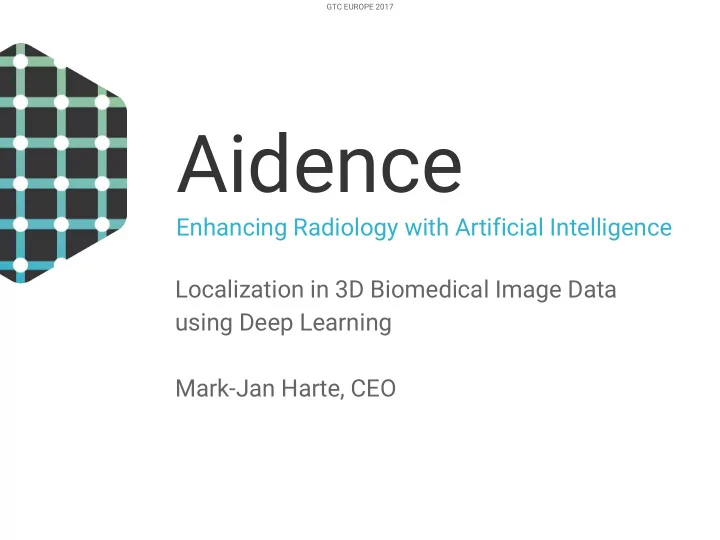

GTC EUROPE 2017 Aidence Enhancing Radiology with Artificial Intelligence Localization in 3D Biomedical Image Data using Deep Learning Mark-Jan Harte, CEO
GTC EUROPE 2017 About Aidence Founded in 2015, based in ● Amsterdam Deep learning for automatic ● medical image analysis 3 rd place in the Kaggle Data ● Science Bowl 2017 2
GTC EUROPE 2017 Challenges for AI in Radiology Technical ○ Sample size Common resolution ImageNet: 256x256x3 = 196.608 Common resolution CT scan: 300x512x512x1 = 78.643.200 Class imbalances due to mostly healthy/background tissue present ○ ○ Accurate labeling is a pain Validation dataset for regulatory approval required ○ 3
GTC EUROPE 2017 Lung Nodules CT Chest Early detection of lung nodules ● leads to 20% mortality reduction Human sensitivity ~80% ● Nodules are: Small ● Anywhere ● Highly variable in number ● 4
GTC EUROPE 2017 Lung Nodules Detection Training Input is 128x128x7 voxels ● Target is 58x58 rectangle mask ● Loss: Normalized cross entropy ● Output: segmentation (probability map) ● Keep fine grained spatial details ● Network size not too big ● Second network to filter out false positives ● ○ Larger, less restrictions 5
GTC EUROPE 2017 Lung Nodules Network architecture Fully 3D convolutional ● ○ Efficient inference on big CT scans No same padding ○ ○ No pooling No strides ○ Dilated convolutions ● ○ Reduce resolution more quickly ○ Keep network size in check (180K params) Weight normalization [Salimans & Kingma, 2016] ● Easier (than batch norm) to distribute over multiple GPUs ○ 6
GTC EUROPE 2017 Lumbar Foramina MR Lumbar Spine Foramen is the passage where a ● nerve exits the spine Foraminal stenosis is a common ● cause of leg pain ○ Time-consuming to find on scoliotic Spines Task: locate and classify all of them ● 7
GTC EUROPE 2017 Lumbar Foramina Localization Foramina are big ● Foramina are located at a certain ● location There are 10 lumbar foramina per spine ● Output a segmentation (probability map) ● Requires less fine grained details ● 8
GTC EUROPE 2017 Lumbar Foramina Localization architecture 3D U-Net architecture ● ○ Easier to modify and/or extend Less need for efficient inference ○ ○ Input: 481x481x3 Binary segmentation (probability map) ● Loss: (Fuzzy) Dice score ● ○ Trains faster and requires less data for our network than the normalized cross entropy loss 9
GTC EUROPE 2017 Lumbar Foramina 10
GTC EUROPE 2017 Lumbar Foramina 11
GTC EUROPE 2017 Lumbar Foramina Combating over-generalization Reduce the resolution for more context ● A segmentation per foramen level ● Bias towards the lower and bigger foramina ● Recall L1 L2 L3 L4 L5 Base 0 0 0 0.97 0.96 12
GTC EUROPE 2017 Lumbar Foramina Combating over-generalization Reduce the resolution for more context ● A segmentation per foramen level ● Bias towards the lower and bigger foramina ● Normalize the Dice score ● Recall L1 L2 L3 L4 L5 Base 0 0 0 0.97 0.96 Normalized 0.87 0.96 0.97 0.98 0.95 13
GTC EUROPE 2017 Lumbar Foramina 14
GTC EUROPE 2017 Lumbar Foramina 15
GTC EUROPE 2017 A Comparison Lung nodules: ● ○ Challenge: Detect small nodules in a vast volume ■ ■ Requires fine grained spatial details Solution: ○ ■ Fully convolutional for efficient inference Dilated convolutions to keep network size in check ■ ■ Trains on 10,000s of samples Lumbar foramina ● ○ Challenge: ■ Detect big foramina in a (relatively) small volume ■ Distinguish lumbar foramina from thoracic ones ○ Solution: ■ Use 3D U-Net with Dice score ■ Normalize the Dice score and reduce the resolution for increased performance ■ Trains on 100s of samples 16
GTC EUROPE 2017 In practice FDA and CE clearance necessary for diagnostic impact ● ○ Certify the training pipeline, inference pipeline, annotation tooling, deployment… Concept of independent test set matches very well ○ ○ Discussions on continuous learning (FDA, ACR) Aidence lung nodule detection submitted for CE ● ○ Feedback received; clearance expected soon 17
GTC EUROPE 2017 “Your software has, in this short time, detected a patient with a nodule that has clearly grown in 3 years, is probably malignant and missed by 4 consecutive radiologists.” W.M, radiologist - markjan@aidence.com 18
Recommend
More recommend